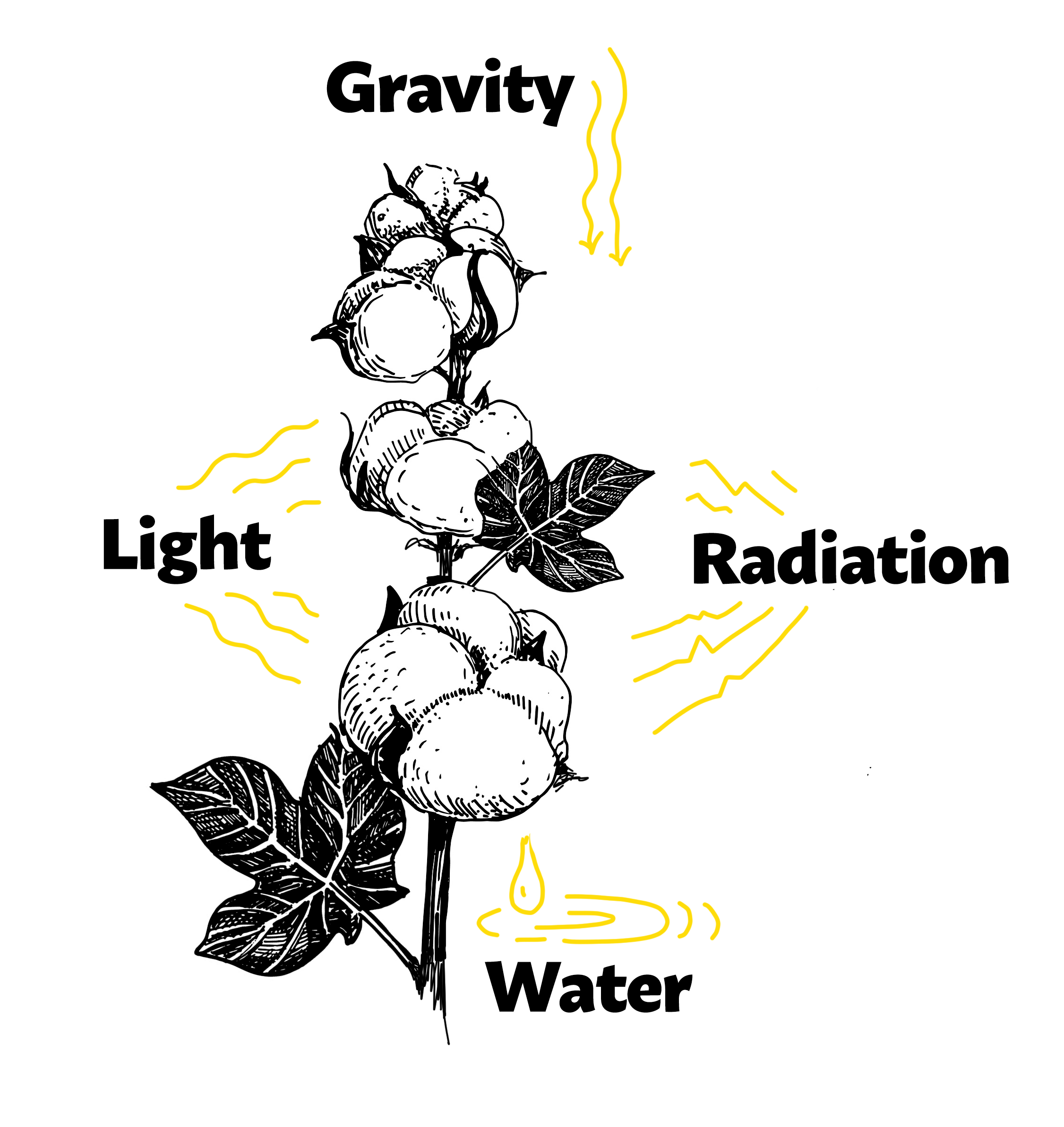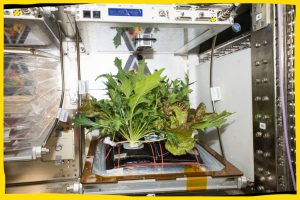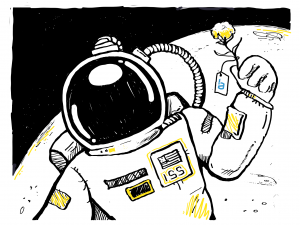An Everyday DNA blog article
Written by: Sarah Sharman, PhD, Science writer
Illustrated by: Cathleen Shaw
Mankind has always looked to the night sky in marvel and wonder about what is in the vast dark, starry beyond. In 1609, Galileo became the first person to record observations of the sky made with the help of a telescope, bringing the mysteries of the great unknown closer to reality.
The first astronaut (well, actually a Soviet cosmonaut) made it to space in 1961, and now non-astronauts are being launched to the edge of the earth’s atmosphere for entertainment. The longest an astronaut has stayed in space at one time is 437 days. But the space community has big visions for humans to one day permanently live in space and on other planets like Mars. To obtain this out of this world goal, scientists are trying to figure out how to sustain life in space without the need for expensive and time-consuming supply deliveries.
Plants offer a promising solution for providing food thousands of miles from Earth. Growing crops in space stations would not only supplement a healthy diet, but also remove toxic carbon dioxide from the air inside the spacecraft and create life-sustaining oxygen. Let’s learn about some of the challenges of growing plants in space and how the solutions also have applications here on Earth.
What are some challenges to growing plants in space?
Growing plants in space is a pretty big challenge. The space community has been trying to do it now for several decades. In order to understand some of the challenges to growing plants in space, let’s first consider some of the elements that affect plant growth and survival.
Gravity
- On Earth, plants take cues from gravity and light for their growth. The gravity pulls the roots down in the ground and helps orient the stem, while the light draws the stems upward. Without gravity or ample light in space, plants don’t have a good sense of where to grow. In low gravity, seeds can also float away if they are not tethered to their growth surface.
- Water distribution in space is also difficult to manage. Water globs up and may drown the plant roots or engulf them in air because of the way fluids in space tend to form bubbles. Or if the water floats away from the roots entirely, the plant would not be able to complete photosynthesis, causing them to eventually wilt and die.
Light
- Space can be a very dark place. Plants need light to grow and most plants on Earth have access to ample amounts of natural sunlight. They grow towards that light and use sunlight, water, and oxygen to produce energy.
- Providing light in space uses up a lot of power, which is in short supply on the space station. Certain types of lightbulbs also produce a lot of heat which must be eliminated from spacecraft. For these reasons, the choice of lighting in the growth chambers in space is an important consideration. Special lights are being developed to provide light for plants without using so much electricity.

Limited available space
- The confined quarters of spacecraft are very different from the large swaths of farmland we have here on Earth. Growth containers must be compact while also packing a big punch in terms of utility. Automation and the ability to regulate watering, humidity, lighting, air circulation, and nutrient delivery are ideal features of a growth system.
- Researchers are working to develop stacked growth containers that take up less space but can grow a variety of different vegetables and plants at once.
How are scientists growing plants in space?

Photo credit: NASA
Plants can be grown in space as long as all of their needs are met. Scientists have developed special containers that address a number of the challenges discussed above. The first portable plant growing box, called Veggie, went to the International Space Station (ISS) in 2014.
The Veggie garden is about the size of a carry-on piece of luggage and typically holds six plants. Each plant grows in a pillow-like pouch filled with a growth media and fertilizer. The pillows are important to help distribute water, nutrients and air in a healthy balance around the roots.
The astronauts first started by growing lettuce in the Veggie system. They failed a few times but eventually took their first bite of space-grown lettuce in 2015. Veggie has now had success growing three types of lettuce, Chinese cabbage, red Russian kale, mizuna mustard and zinnia flowers in space.
In addition to two Veggie grow boxes, the ISS also has another type of plant growth system called Advanced Plant Habitat. Advanced Plant Habitat is similar to Veggie but it is enclosed and automated with cameras and more than 180 sensors that are in constant interactive contact with a team on Earth. It does not require much day-to-day care from the crew.
Advanced Plant Habitat has more colors of LED lights than Veggie, with red, green, and blue lights, but also white, far red and even infrared to allow for nighttime imaging of the plants. In late 2021, astronauts successfully used the Advanced Plant Habitat to grow chili peppers. They harvested the peppers and ate a few before packing the rest up to return to Earth for analysis.
Can space plants teach us anything about plants on Earth?
 Learning how to grow plants in space teaches scientists how to grow plants more efficiently in challenging environments back here on earth. The ISS is a U.S. National Laboratory that serves as an important location for making research breakthroughs and technological advances not possible on Earth.
Learning how to grow plants in space teaches scientists how to grow plants more efficiently in challenging environments back here on earth. The ISS is a U.S. National Laboratory that serves as an important location for making research breakthroughs and technological advances not possible on Earth.
Researchers at the HudsonAlpha Institute for Biotechnology are part of a project that recently sent cotton cells to the ISS aboard a SpaceX Dragon resupply mission. The project was selected as a winner in the Cotton Sustainability Challenge, run by the Center for the Advancement of Science in Space, and sponsored by the Target Corporation.
The project, entitled “Unlocking the Cotton Genome to Precision Genetics,” explores the cotton genome and how it reacts differently in micro-gravity and normal gravity. Scientists at the HudsonAlpha Genome Sequencing Center and the lab of Chris Saski, PhD, at Clemson University will sequence both the Earth-grown samples and the samples that return from space, searching for differences on the genetic level.
Cotton has very little diversity as a species which limits the possibilities of improving the sustainability of cotton through traditional breeding techniques. Through this project, the researchers hope to accelerate the speed at which scientists can transform cotton. This would open up the ability to rapidly test genes linked to beneficial traits and make positive targeted modifications in important cotton lines for US growers and the many industries that depend on high quality cotton production.
To learn more about the cotton project, you can check out this story from Clemson. Or if listening is more your thing, head over to the Tiny Expeditions website to hear about this and other cool projects about plants in space.


